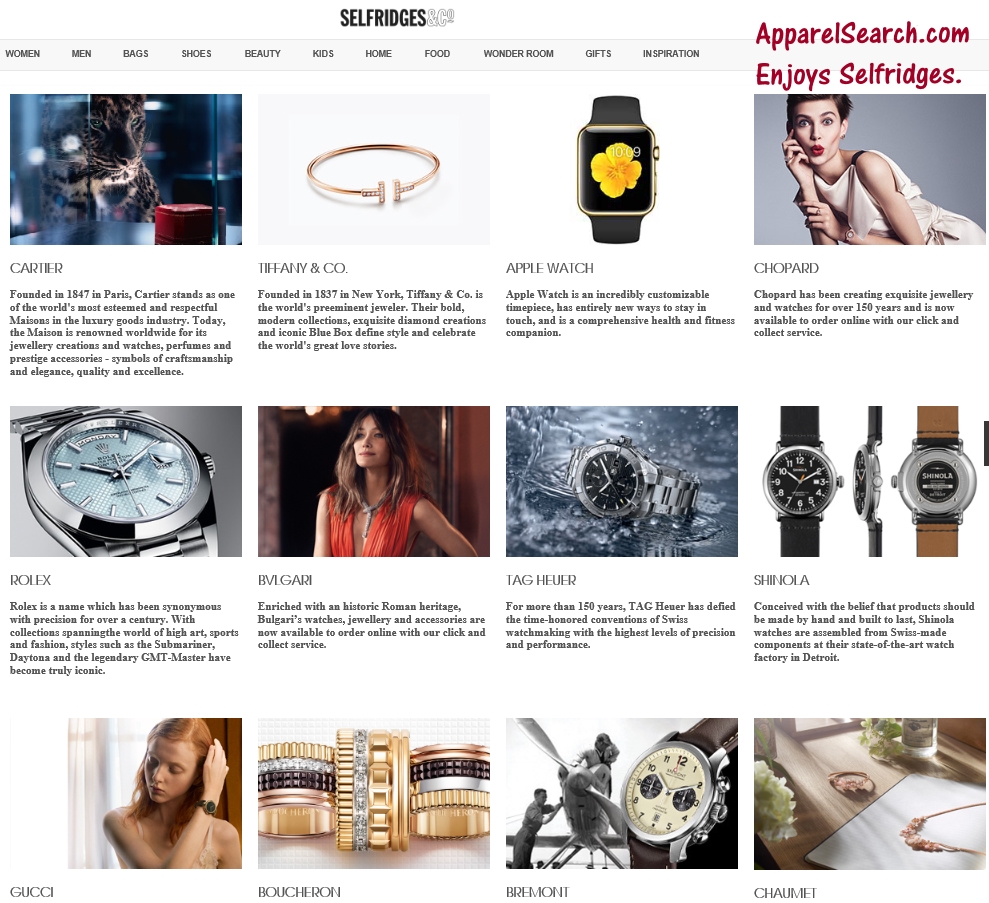In 1906, Harry Gordon Selfridge arrived in London from Chicago with his heart set on opening his dream store. With his revolutionary understanding of publicity and the theatre of retail, Selfridges flourished under the direction of its charismatic Chief.
![]() The basis of Selfridge's success was his relentlessly innovative
marketing, which was elaborately expressed in his Oxford Street store.
Originally from America himself, Selfridge attempted to dismantle the
idea that consumerism was strictly an American phenomenon. He tried to
make shopping a fun adventure and a form of leisure instead of a chore,
transforming the department store into a social and cultural landmark
that provided women with a public space in which they could be
comfortable and legitimately indulge themselves. Emphasizing the
importance of creating a welcome environment, he placed merchandise on
display so customers could examine it, moved the highly profitable
perfume counter front-and-centre on the ground floor, and established
policies that made it safe and easy for customers to shop. These
techniques have been adopted by modern department stores around the
world. Either Selfridge or Marshall Field is popularly held to have
coined the phrase "the customer is always right", and Selfridge used it
regularly in his advertising.
The basis of Selfridge's success was his relentlessly innovative
marketing, which was elaborately expressed in his Oxford Street store.
Originally from America himself, Selfridge attempted to dismantle the
idea that consumerism was strictly an American phenomenon. He tried to
make shopping a fun adventure and a form of leisure instead of a chore,
transforming the department store into a social and cultural landmark
that provided women with a public space in which they could be
comfortable and legitimately indulge themselves. Emphasizing the
importance of creating a welcome environment, he placed merchandise on
display so customers could examine it, moved the highly profitable
perfume counter front-and-centre on the ground floor, and established
policies that made it safe and easy for customers to shop. These
techniques have been adopted by modern department stores around the
world. Either Selfridge or Marshall Field is popularly held to have
coined the phrase "the customer is always right", and Selfridge used it
regularly in his advertising.
Selfridges' windows have become synonymous also with the brand, and to a certain degree have become as famous as the company and Oxford Street location itself. Selfridges has a history of bold art initiatives when it comes to the window designs. Selfridge himself likened the act of shopping to the act of attending the theater and encouraged his customers to make this connection as well by covering his show windows with silk curtains before dramatically unveiling the displays on opening day. Just as they do today, the window designs served as the opening act of the entire play of the Selfridge experience and helped capture the public’s attention to transform customers into true shoppers.
In the 1940s, smaller provincial Selfridge stores were sold to the John Lewis Partnership, and in 1951 the original Oxford Street store was acquired by the Liverpool-based Lewis's chain of department stores. Lewis's and Selfridges were then taken over in 1965 by the Sears Group owned by Charles Clore. Expanded under the Sears group to include branches in Manchester and Birmingham, in 2003 the chain was acquired by Canada's Galen Weston. Harry Gordon Selfridge's spirit of innovation and creativity lives on through its owners today.
Selfridges, also known as Selfridge & Co., is a chain of high end department stores in the United Kingdom. It was founded by Harry Gordon Selfridge. The flagship store on London's Oxford Street is the second largest shop in the UK.
2016 Spotlight: 2016 marks the fifth year of Selfridges' seminal Bright Young Things talent platform. To celebrate this anniversary, they will not only honour its legacy, but invest in the future. Bright New Things will champion some of the UK’s most exciting talents, and by working in collaboration with the Centre for Sustainable Fashion, they will put the focus on sustainability. Via a selection process open to all ages, they have selected nine candidates who put sustainability and innovative design side by side at the heart of their practice.
Note: the items pictures above may no longer be available. This is simply an example of the types of product that has been offered at Selfridges.
Learn more about the company at https://www.selfridges.com/
Thank you for using the Apparel Search website.
